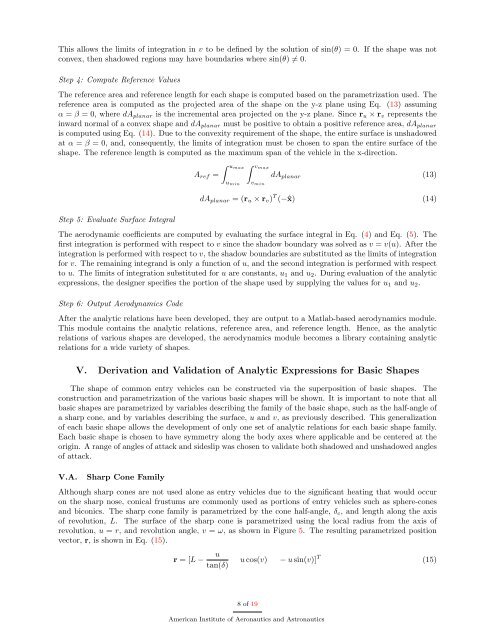Analytic Hypersonic Aerodynamics for Conceptual Design of Entry ...
Analytic Hypersonic Aerodynamics for Conceptual Design of Entry ...
Analytic Hypersonic Aerodynamics for Conceptual Design of Entry ...
Create successful ePaper yourself
Turn your PDF publications into a flip-book with our unique Google optimized e-Paper software.
This allows the limits <strong>of</strong> integration in v to be defined by the solution <strong>of</strong> sin(θ) = 0. If the shape was not<br />
convex, then shadowed regions may have boundaries where sin(θ) = 0.<br />
Step 4: Compute Reference Values<br />
The reference area and reference length <strong>for</strong> each shape is computed based on the parametrization used. The<br />
reference area is computed as the projected area <strong>of</strong> the shape on the y-z plane using Eq. (13) assuming<br />
α = β = 0, where dAplanar is the incremental area projected on the y-z plane. Since ru × rv represents the<br />
inward normal <strong>of</strong> a convex shape and dAplanar must be positive to obtain a positive reference area, dAplanar<br />
is computed using Eq. (14). Due to the convexity requirement <strong>of</strong> the shape, the entire surface is unshadowed<br />
at α = β = 0, and, consequently, the limits <strong>of</strong> integration must be chosen to span the entire surface <strong>of</strong> the<br />
shape. The reference length is computed as the maximum span <strong>of</strong> the vehicle in the x-direction.<br />
Step 5: Evaluate Surface Integral<br />
Aref =<br />
umax vmax<br />
umin<br />
vmin<br />
dAplanar<br />
(13)<br />
dAplanar = (ru × rv) T (−ˆx) (14)<br />
The aerodynamic coefficients are computed by evaluating the surface integral in Eq. (4) and Eq. (5). The<br />
first integration is per<strong>for</strong>med with respect to v since the shadow boundary was solved as v = v(u). After the<br />
integration is per<strong>for</strong>med with respect to v, the shadow boundaries are substituted as the limits <strong>of</strong> integration<br />
<strong>for</strong> v. The remaining integrand is only a function <strong>of</strong> u, and the second integration is per<strong>for</strong>med with respect<br />
to u. The limits <strong>of</strong> integration substituted <strong>for</strong> u are constants, u1 and u2. During evaluation <strong>of</strong> the analytic<br />
expressions, the designer specifies the portion <strong>of</strong> the shape used by supplying the values <strong>for</strong> u1 and u2.<br />
Step 6: Output <strong>Aerodynamics</strong> Code<br />
After the analytic relations have been developed, they are output to a Matlab-based aerodynamics module.<br />
This module contains the analytic relations, reference area, and reference length. Hence, as the analytic<br />
relations <strong>of</strong> various shapes are developed, the aerodynamics module becomes a library containing analytic<br />
relations <strong>for</strong> a wide variety <strong>of</strong> shapes.<br />
V. Derivation and Validation <strong>of</strong> <strong>Analytic</strong> Expressions <strong>for</strong> Basic Shapes<br />
The shape <strong>of</strong> common entry vehicles can be constructed via the superposition <strong>of</strong> basic shapes. The<br />
construction and parametrization <strong>of</strong> the various basic shapes will be shown. It is important to note that all<br />
basic shapes are parametrized by variables describing the family <strong>of</strong> the basic shape, such as the half-angle <strong>of</strong><br />
a sharp cone, and by variables describing the surface, u and v, as previously described. This generalization<br />
<strong>of</strong> each basic shape allows the development <strong>of</strong> only one set <strong>of</strong> analytic relations <strong>for</strong> each basic shape family.<br />
Each basic shape is chosen to have symmetry along the body axes where applicable and be centered at the<br />
origin. A range <strong>of</strong> angles <strong>of</strong> attack and sideslip was chosen to validate both shadowed and unshadowed angles<br />
<strong>of</strong> attack.<br />
V.A. Sharp Cone Family<br />
Although sharp cones are not used alone as entry vehicles due to the significant heating that would occur<br />
on the sharp nose, conical frustums are commonly used as portions <strong>of</strong> entry vehicles such as sphere-cones<br />
and biconics. The sharp cone family is parametrized by the cone half-angle, δc, and length along the axis<br />
<strong>of</strong> revolution, L. The surface <strong>of</strong> the sharp cone is parametrized using the local radius from the axis <strong>of</strong><br />
revolution, u = r, and revolution angle, v = ω, as shown in Figure 5. The resulting parametrized position<br />
vector, r, is shown in Eq. (15).<br />
r = [L − u<br />
tan(δ)<br />
u cos(v) − u sin(v)] T<br />
8 <strong>of</strong> 19<br />
American Institute <strong>of</strong> Aeronautics and Astronautics<br />
(15)

















